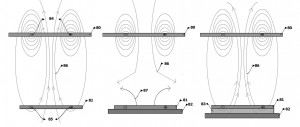There are few considerations when designing a RFID device. One of them is presence of eddy currents. Eddy currents are fields of alternating currents induced in conductors (e.g., metal or any other conductors having low impedances) caused by coupled alternating magnetic fields. The induced eddy currents create distinct magnetic fields that could weaken the inductive power and data transfer of the RFID device. As such, communication performance of the RFID device with other RFID devices such as, for example, a Proximity Coupling Reader (PCR) can be degraded. At the same time, the induced eddy currents may generate excessive and undesirable heat which become safety hazard, especially when the RFID devices will be communicating for a significant period of time.
A RFID transponder may have issues communicating with a coupled PCR when a metallic object is located within close proximity. For example, RFID antenna coil 84 of the coupled PCR having reference plane 80 generates an alternating magnetic field 86. In the Left View, alternating magnetic field 86 overlaps with antenna coil 85 of RFID transponder having reference plane 81. Furthermore, the resonant frequency of antenna coil 84 is tuned to the resonant frequency of antenna coil 85.
In the Center View, metal conductor 82 is immediately below (or could be immediately above in other design situations) antenna coil 85. Alternating magnetic field 86 induces eddy currents on metal conductor 82. In return, the eddy currents generates its own alternating magnetic field 87 which weakens (or cancels out) alternating magnetic field 86 around antenna coil 85. The resonant frequency of antenna coil 85 changes and no longer match that of antenna coil 84. As a result, quality of communication between antenna coils 84 and 85 is degraded. For example, the operating distance between antenna coils 84 and 85 is reduced.
There are a few ways to mitigate the effects of eddy currents. One of them is the use of highly magnetic-permeable mu-metal, or any other material with properties similar to mu-metal. Mu-metal is a nickel-iron soft magnetic alloy with very high permeability suitable for sensitive electronic equipment shielding. For example, in the Right View, a thin layer magnetic sheet 83 is inserted between antenna coil 85 and metal conductor 82. The thin layer magnetic sheet 83 is an ultra-thin film of mu-metal. As such, magnetic sheet 83 is able to focus magnetic field 86, guide it away from metal conductor 82, and allow magnetic field 86 to flow freely within magnetic sheet 83 with minimal loss in flux density. This may result in significant improvement with the quality of the communication between the antenna coils 84 and 85, even in the presence of metal conductor 82.
If metal conductor 82 is immediately above antenna coil 85, discontinuities could be designed into metal conductor 82 such that characteristics of the flow of eddy currents in metal conductor 82 are modified to the extent that the strength of alternating magnetic field 87 is reduced. Another way is to change the property of the metal conductor 82 (e.g., thickness, conductivity etc).
History of Eddy Currents
Eddy currents was discovered by French physicist Leon Foucault in 1851. Foucault built a device that used a copper disk moving in a strong magnetic field to show that eddy currents are generated when a conductive material moves within the magnetic field.
In 1831, Michael Faraday discovered that when a magnetic field passes through a conductor or when a conductor passes through a magnetic field, an electric current will flow through the conductor if there is a closed path through which the current can circulate. In 1879, another English scientist, David Hughes, demonstrated how the properties of a coil change when placed in contact with metals of different conductivity and permeability.
If you have any further comments or suggestions about this article, please leave a comment.

